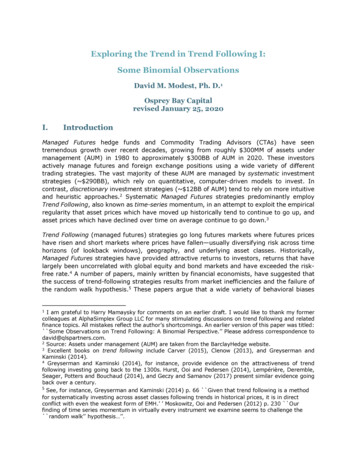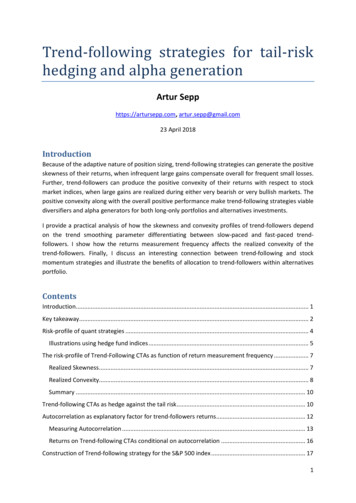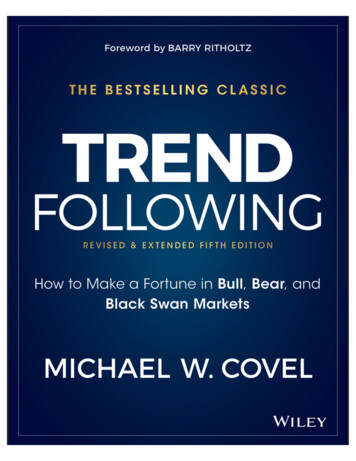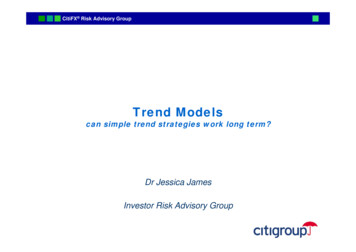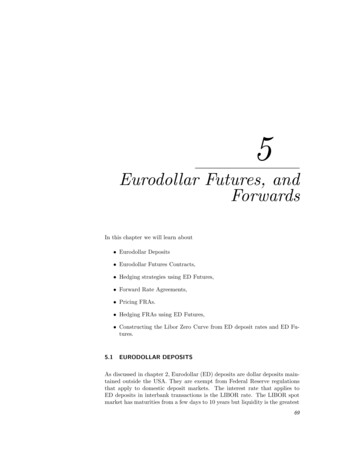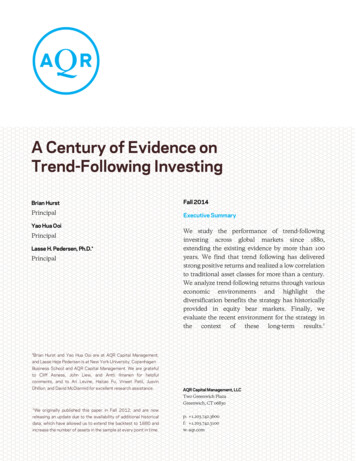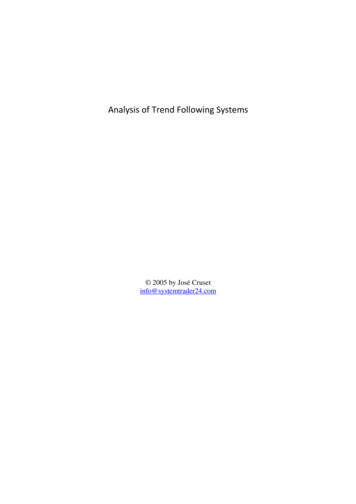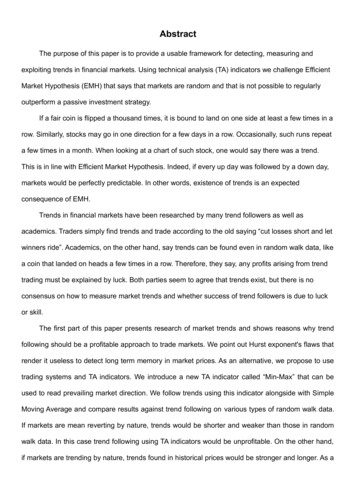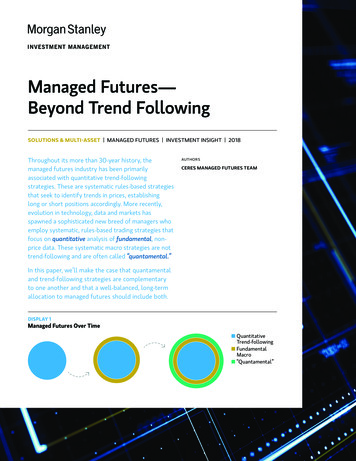
Transcription
Managed Futures—Beyond Trend FollowingSOLUTIONS & MULTI-ASSET MANAGED FUTURES INVESTMENT INSIGHT 2018Throughout its more than 30-year history, themanaged futures industry has been primarilyassociated with quantitative trend-followingstrategies. These are systematic rules-based strategiesthat seek to identify trends in prices, establishinglong or short positions accordingly. More recently,evolution in technology, data and markets hasspawned a sophisticated new breed of managers whoemploy systematic, rules-based trading strategies thatfocus on quantitative analysis of fundamental, nonprice data. These systematic macro strategies are nottrend-following and are often called “quantamental.”AUTHORSCERES MANAGED FUTURES TEAMIn this paper, we’ll make the case that quantamentaland trend-following strategies are complementaryto one another and that a well-balanced, long-termallocation to managed futures should include both.DISPLAY 1Managed Futures Over Time QuantitativeTrend-following FundamentalMacro “Quantamental”
INVESTMENT INSIGHTEvolution in ManagedFutures StrategiesThe managed futures universe hasexpanded rapidly in recent years,mirroring ongoing trends in technology,data and the markets (Display 2).Computing PowerEnhanced computing power is at the coreof this evolution. Futures and forwardsmarkets are attractive to systematictrading managers because they are easyto trade.1 The ability to transact long orshort positions with equal ease coupledwith the liquidity and transparent pricingof these markets allows futures managersto test new rules-based investmentstrategies readily. Increased speed ofcomputers, artificial intelligence, machinelearning and application of engineeringprinciples that are widely used in suchareas as driverless cars all portend furtherresearch and development in systematictrading of futures.Market ProliferationThe composition of the futures marketshas evolved as well, reflecting growthand demand in the underlying cashmarketplace. For example, frozen orangejuice futures were at one time a veryliquid market. As consumers’ tasteschanged, so did the demand for frozenorange juice. Today, the contract tradeswith relatively small volume.2 At theother end of the spectrum, VIX futuresdid not exist before 2004, and today theyare a broadly traded and liquid market.3Looking ahead, certain emergingmarkets’ futures markets are availabletoday primarily for users in their localmarkets only, but we expect that one daythey will be available for global traders.This dynamic way that futures marketsevolve ensures that futures managers willDISPLAY 2The Evolution in Managed Futures nicTrading Platformshave access to the markets most relevantto the global economy.Electronic Trading PlatformsUS futures markets began in the 1800’swith traders communicating theirorders to one another on a trading floor.This continued well into the 2000’s;in fact, the Chicago Board of Trade’sphysical exchange didn’t close its doorsuntil the end of 2016. Some physicalexchanges still do exist, but the majorityof the volume in futures trading today istransacted via electronic exchanges. Theadoption of electronic trading platformshas dramatically reduced costs whileincreasing trading volume and liquidityin the futures markets.4Data AvailabilityThe first data inputs broadly available forsystematic analysis were closing prices.Today, minute-to-minute tick data andvolume and open interest data can serveas model inputs. Increasingly, broader,DataAvailabilitymore readily available fundamental data,such as macroeconomic statistics, supply/demand data, inventory data, tradeflow data, weather data and interest ratedifferentials allow for development of awider number of unique and independentdata inputs.Advancements in electronic gatheringof data, methods of storage and speedof transmission all combine to ensurethat data attainment remains a preciousdifferentiator among managers. Somemanagers are even creating “new” andproprietary sources of data.For example, today’s satellites cantrack ships at sea; road traffic can bescrutinized; and receipts for purchasescan be obtained on a routine basis. Takentogether, these represent new, real-timesources of data that can help determineinventory levels. These new data sets canbe fed into rules-based models that areseeking to identify value in prices andinefficiencies in asset pricing relationships.Forward contracts are different than futures structurally, but share many of the traits of futures which make them conducive to systematic trading.“Orange Juice Futures Leave Sour Taste for Investors”, Financial Times (February 8, 2017)3Wikipedia4Source: CME Group: of-achievements.html122MORGAN STANLEY INVESTMENT MANAGEMENT SOLUTIONS & MULTI-ASSET
MANAGED FUTURES—BEYOND TREND FOLLOWINGBeyond Trend-FollowingTrend-following models are predominatelybased on the momentum of price. Ifan expected trend pattern does notmaterialize, positions must be reducedor even eliminated. The trend-followingadage is to “cut losers and let winnersrun”. Display 3 illustrates a classic trendfollowing model with buy and sell signals.DISPLAY 3Classic Trend-Following SchematicStart SellingIn the paragraphs that follow, wepresent a few of the non-trend factorson which quantamental strategies focus.Actual implementation by a managerwould be more complex than thesesimplistic descriptions.Start BuyingINTRA-FUTURES MARKETS:CARRY/ROLL YIELDA roll yield strategy is based on a costof carry factor that is specific to futuresmarkets, particularly commodity futures.Futures contracts trade in a series ofexpiration dates. The spot, or immediatecash price, differs from the nearestterm futures contract, which in turndiffers from later-dated contracts. Thedifference between spot and future pricesincludes the cost of carry. Cost of carry iscalculated based on interest costs related tofinancing the purchase, as well as storingand insuring the underlying asset. Thesecosts interact with supply/demand pricingpressures and result in either a contango(upward sloping) or backwardation(downward sloping) curve. Long/shortcommodity managers will integrate curveslope into their trading strategies.As seen in Display 4, a long commodityposition in a backwardated contract mayallow a manager to benefit from positiveroll yield; a long position “rolls up” thefutures curve as it nears the higher spotprice. Conversely, a long commodityposition in a contango market willexperience a negative roll yield; it wouldroll “down the curve” and lose value astime passes. A short position may farebetter in a contango market.We observe that a roll yield strategy isbased on a factor that is driven by marketbehavior less related to price trends. AsThe chart is provided for illustrative purposes only and is not meant to depict any specific investment.DISPLAY 4Intra-Futures Market Carry/Roll YieldPriceLong Position: Positive RollLong Position: Negative RollTime to FuturesExpirationTodayContangoBackwardationThe chart is provided for illustrative purposes only and is not meant to depict any specific investment.such, it could be a diversifying strategy totrend-following.INTRA-FUTURES MARKETS:RELATIVE VALUECertain commodity complexes, suchas soybeans, soy oil and soy meal, arerelated to each other by nature of theirprocessing. The cost of this processingcan be calculated and a “normal” spreadSOLUTIONS & MULTI-ASSET can be observed. From the producer’spoint of view, the spread representsthe profit they would like to make. Ifthis spread becomes distorted from acalculated norm, a trader can place atrade with the expectation that the spreadwill revert to the norm and generate apositive return over time.Spread trading involves risks, as neitherreversion to the norm nor its timing is aMORGAN STANLEY INVESTMENT MANAGEMENT3
INVESTMENT INSIGHTcertainty. However, one can observe thatthis type of trading is very different fromtrend trading.VALUE-SEEKING: MACROBy harnessing computing power and newsources of data, quantamental managerscan study and identify a large universe ofpossible inputs. Further, by systemizingtheir processes, they can take positions ina large number of markets.For example, GPS-based transportationactivity analysis or electricity usagestatistics may provide timely informationon the level of a country’s economicactivity. A value-focused systematic macromanager may consider this informationwhen establishing a long futures positionin the equity index of a country with arobust macroeconomic outlook and a shortposition in the equity index of a countrywith relatively poor macro metrics.These sources of data offer quantitativemacro traders new inputs and newtrading rationales that differ from trendfollowing and offer diversified exposuresin futures trading.PATTERN RECOGNITIONThis category applies broadly to identifyingprice patterns that have been observedhistorically and have frequently beenfollowed by a specific price move. Patternrecognition is related to trend followingin that it relies solely on price as an input.However, the entry and exit timing of sucha trade may differ from trend-following,thus offering a differentiated style.Such patterns are frequently given namesthat reflect their appearance in charts. Forexample, one such pattern is referred to asa “head and shoulders” pattern, which may54DISPLAY 5Pattern Recognition Example604020HeadRight ShoulderLeft he chart is provided for illustrative purposes only and is not meant to depict any specific investment.suggest when an existing trend is reversing.In Display 5 above you can observe sucha formation. A pattern recognition traderwould view this formation as portending alower future price.For years, traders relied on the visualidentification of such simplistic patterns.Computational power today allowsfor the research and identification ofnew patterns and subsequent tradingaction. Pattern recognition is a categorywhere machine learning and artificialintelligence are being widely applied.5ConclusionThe managed futures industry has evolvedfrom trend-following into a diversifiedset of quantitative trading strategies thatbenefit from proliferating data availabilityand ever-increasing computing power.Trend following and quantamentalstrategies are complementary to oneanother and tend to operate differently indifferent types of market conditions.Anzai, Y. (1992) Pattern Recognition and Machine Learning. Morgan Kaufman.MORGAN STANLEY INVESTMENT MANAGEMENT SOLUTIONS & MULTI-ASSETAs with any strategy seeking to capturea market inefficiency, decay of theinefficiency due to an influx of capitalis a real danger. The consistency of thestrategy’s alpha is highly dependent onongoing research and efficient execution.This fact, along with the fact that thesystems required for success can be verysophisticated, argue for partnering with aprofessional team when seeking to investin these managers.Trend following remains at the heartof managed futures. Indeed, this trendelement is what lends to the convexity offutures returns that have been historicallyassociated with sustained downwardmovement in equity markets. Yet,quantamental styles may prove to bediversifying during the periods in whichtrend factors are out of favor. Investorswho are comfortable with the risks ofmanaged futures could be well-served byincluding allocations to each in a welldiversified portfolio.
MANAGED FUTURES—BEYOND TREND FOLLOWINGRisk ConsiderationsDiversification does not eliminate the risk of loss.Managed futures investments should be considered as part of a diversified investment portfolio. Morgan Stanley InvestmentManagement considers managed futures investments suitable solely for the risk capital portion of such a portfolio. If a managedfutures fund does not perform in a manner that has a low correlation to the performance of traditional financial markets or doesnot perform successfully, investors will obtain no diversification benefits by investing in such fund, and there is no guarantee that amanaged futures investment will provide such benefits. Investments in futures, forwards, and options on futures and forwards trading is speculative and volatile and an investor could loseall or a substantial part of his or her investment. Key risks to consider when investing in managed futures strategies include thefollowing: Strategies generally employ substantial leverage in their trading which accentuates the trading profit and trading loss; Strategies may trade on non-U.S. exchanges and in the over-the-counter market which may not be subject to regulation by theCommodity Futures Trading Commission;– Liquidity is restricted; there may be no secondary market for units in managed futures strategies and such units may be subjectto restrictions on transfer;– Fees and expenses can be substantial and will reduce trading profits and investment returns;– Trading advisors may receive quarterly or annual incentive fees, without regard to the overall performance of any of thefunds; and– Profits earned by managed futures funds will be taxable to an investor even though distributions will not be paid to investors.SOLUTIONS & MULTI-ASSET MORGAN STANLEY INVESTMENT MANAGEMENT5
INVESTMENT INSIGHTDEFINITIONSBackwardation: Backwardation exists when the futures price is below theexpected future spot price for a particular commodity.Contango: Contango exists when the futures price of a commodity is abovethe expected spot price.IMPORTANT INFORMATIONThe views and opinions are those of Morgan Stanley Investment Managementas of the date of publication and are subject to change at any time dueto market or economic conditions and may not necessarily come to pass.Furthermore, the views will not be updated or otherwise revised to reflectinformation that subsequently becomes available or circumstances existing,or changes occurring, after the date of publication. The views expresseddo not reflect the opinions of all portfolio managers at Morgan StanleyInvestment Management (MSIM) or the views of the firm as a whole, andmay not be reflected in all the strategies and products that the MSIM offers.Forecasts and/or estimates provided herein are subject to change and maynot actually come to pass. Information regarding expected market returnsand market outlooks is based on the research, analysis and opinions ofMSIM. These conclusions are speculative in nature, may not come to passand are not intended to predict the future performance of any specificMorgan Stanley Investment Management product.Certain information herein is based on data obtained from third party sourcesbelieved to be reliable. However, we have not verified this information, andwe make no representations whatsoever as to its accuracy or completeness.This material is a general communication, which is not impartial and allinformation provided has been prepared solely for informational andeducational purposes and does not constitute an offer or a recommendationto buy or sell any particular security or to adopt any specific investment6MORGAN STANLEY INVESTMENT MANAGEMENT strategy. The information herein has not been based on a consideration of anyindividual investor circumstances and is not investment advice, nor should itbe construed in any way as tax, accounting, legal or regulatory advice. To thatend, investors should seek independent legal and financial advice, includingadvice as to tax consequences, before making any investment decision.Investing involves risks including the possible loss of principal. Any personsubscribing for a managed futures investment must be able to bear therisks involved and must meet the specific suitability requirements relatingto such investment. Such suitability requirements may vary dependingon the nature of the offered investment. An offer or solicitation withrespect to any managed futures investment may only be made pursuantto a current prospectus and/or offering document. This presentation is forinformational purposes only.PA S T PERFORM A NCE IS NOT N ECESSA RI LY I N DIC AT I V E OFFUTURE RESULTS.This communication is not a product of Morgan Stanley’s ResearchDepartment and should not be regarded as a research recommendation.The information contained herein has not been prepared in accordance withlegal requirements designed to promote the independence of investmentresearch and is not subject to any prohibition on dealing ahead of thedissemination of investment research.NOT FDIC INSURED OFFER NO BANK GUARANTEE MAY LOSEVALUE NOT INSURED BY ANY FEDERAL GOVERNMENT AGENCY NOT A DEPOSITMorgan Stanley Investment Management is the asset management divisionof Morgan Stanley.All information contained herein is proprietary and is protected undercopyright law.SOLUTIONS & MULTI-ASSET
MANAGED FUTURES—BEYOND TREND FOLLOWINGSOLUTIONS & MULTI-ASSET MORGAN STANLEY INVESTMENT MANAGEMENT7
INVESTMENT INSIGHTExplore our site at www.morganstanley.com/im 2018 Morgan Stanley. Morgan Stanley Distribution, Inc. All rights reserved. CRC 2229665 Exp. 8/1/20199353893 KC 0918US
Beyond Trend-Following Trend-following models are predominately based on the momentum of price. If an expected trend pattern does not materialize, positions must be reduced or even eliminated. The trend-following adage is to “cut losers and let winners run”. Display 3 illustrates a classic trend-
